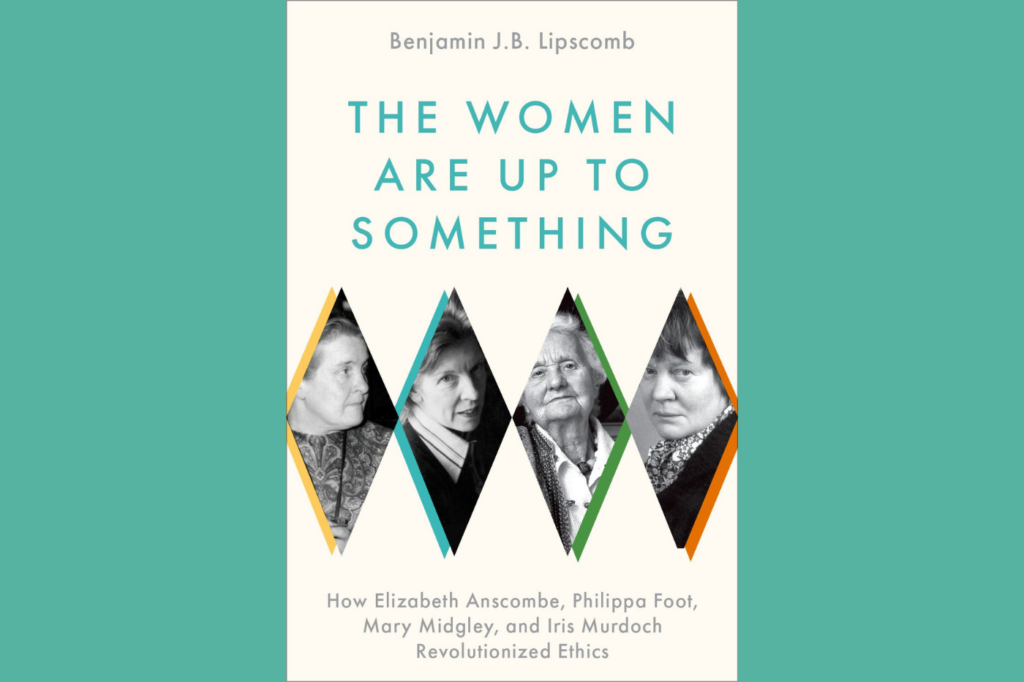Until the past few years, it was easy to forget—or miss entirely—the link between Mary Midgley and her university friends Elizabeth Anscombe, Philippa Foot, and Iris Murdoch.
There are several reasons why Midgley hasn’t registered as part of a group with the others, starting with the unusual shape of her career. Midgley was on the same trajectory as her friends—undergraduate degree, war work, graduate studies, first academic job—until 1950, when she resigned her post at the University of Reading, married, and followed her husband to Newcastle. She never ceased being a philosopher—and never ceased thinking of herself as one. In 1956, she was billed for one of her many BBC talks as “a writer and lecturer in philosophy.” But by 1951, Midgley had stepped away from the world of professional philosophy, as Murdoch would do a dozen years later.
Midgley remained an active cultural critic through the mid-1950s, broadcasting regularly on the BBC and writing reviews and thought pieces for major literary and cultural magazines. By that time, she had already begun to work unsystematically but steadily on the project that would occupy her for the rest of her life: understanding the continuities between human beings and the rest of the natural world. But it would be another fifteen to twenty years before she would be ready to publish about it. She can thus seem like a writer of a different generation.
Consider: by 1960, Anscombe had not only said her piece about Oxford moral philosophy but had also published both of her monographs. Foot had established herself as Hare’s preeminent critic, and Murdoch was already turning away from philosophy and toward fiction; but the first of Midgley’s sixteen books was eighteen years away. It is easy, then, to miss the generational tie between Midgley and her friends.
Start your day with Public Discourse
Sign up and get our daily essays sent straight to your inbox.Midgley’s work has also not had the same impact in professional philosophical circles as that of her friends, though she is better known outside the academy than either Anscombe or Foot. Midgley was a deliberately multidisciplinary thinker. Early on—it is hard to say exactly when or how—she became convinced that moral philosophers must relate various bodies of knowledge to one another if they are to achieve an adequate understanding of human life, human motivation, and human success or failure. This unconfined tendency aligned Midgley more with Murdoch than with Anscombe and Foot, even during their postgraduate years. In a journal entry from 1948, Murdoch exults, “I talk philosophy with E. & P. & psychology with Mary!”
Midgley was a deliberately multidisciplinary thinker. Early on—it is hard to say exactly when or how—she became convinced that moral philosophers must relate various bodies of knowledge to one another if they are to achieve an adequate understanding of human life, human motivation, and human success or failure.
Developing a Naturalistic Moral Philosophy
There was precedent for the sort of integrative work Midgley wanted to do—and she knew it. This is how Aristotle approaches ethics: as a biologist studying an animal of particularly absorbing interest. Aristotle’s “works” are widely thought to be student notes on the lectures he delivered at the Lyceum. His Nicomachean Ethics lectures pick up directly from his lectures On the Soul—the psyche—and continue from there to his lectures on Politics. Everything is connected to everything else, and biology and psychology and ethics and politics have to be considered in relation to one another. But this kind of integrative approach had become rare.
Following Aristotle’s example, Midgley always shaped her writing with reference to an audience broader than any one disciplinary guild. “Because so many disciplines border [my] topic,” she wrote in her breakthrough book, Beast and Man, “it must necessarily be discussed in plain language.” She would later liken philosophy to plumbing. It is the unpretentious business of working out kinks and blockages in people’s houses of thought. But again: plainness of purpose and speech does not always command respect. Neither do plumbers.
It was the integrative, multidisciplinary character of Midgley’s work that made it important, though. Her friends’ work was chiefly critical. Essays like Anscombe’s “Modern Moral Philosophy” and Foot’s “Moral Beliefs”—even many of Murdoch’s philosophical writings—were attacks on a dominant way of conceiving ethics; at most, they gestured toward what might take its place. This is understandable, considering that the views they promoted were minority ones, unlikely to receive a hearing unless dominant, opposing views were not first undermined. It was also the predictable result of working within the genres of the professional society talk or the journal article. These genres are best suited to targeted attacks or incremental refinements, not the elaboration of large, visionary proposals.
Midgley, writing from the margins of the discipline, was the first to present a positive proposal for the kind of moral philosophy recommended but never developed by Anscombe, Foot, and Murdoch: a naturalistic moral philosophy, grounded in the character and needs of the human animal. Indeed, she was the only one who could, the only one who knew both enough biology and enough moral philosophy to relate the two fields.
Women’s Particularities
Still, Newcastle and domestic life were isolating. Though both were shaping her in far-reaching ways, and though she was impatient with their cultured despisers, there was no denying it: Midgley had less time for scholarship during the 1950s and early 1960s, and less conversation outside the home. Her most philosophical writings of the 1950s came early in the decade and were not published in philosophy journals. They are interesting, though; they highlight two themes on which Midgley was reflecting as she went into a chrysalid state. The first theme is about philosophy itself; the second concerns human nature. When she returned to the discipline in the mid-1960s, she would return to these themes, informed by a wealth of extra-philosophical reading.
Both themes surface in an early piece on sexual difference. Midgley was the only one of her friends to publish about sex and gender, though these publications are obscure. (Her co-authored 1982 book Women’s Choices is, she noted in 2005, “the only one of my books that is not in print.”) Her first reflections on these matters appeared in 1952, in a talk for the BBC Home Service: “A Letter to Posterity.” Her assignment was to anticipate how the situation of women might change in the century ahead.
“My dear Posterity . . . ,” Midgley began, and told Posterity straightaway that institutional discrimination, of the sort at stake in pre-1920 debates on women’s rights, was finished. “I’m not saying that there is no injustice,” she said. “But . . . it is not the profound difference in status that feels like a difference in species.” In light of this, Midgley asked, what ought to be expected of women now that they had been “admitted to a thousand mysteries from classical scholarship to engineering”? For, she said, women as a group “still have their own peculiarities. They still defeat Plato and those other feminists who . . . think of them simply as men who have accidentally come out the wrong shape.”
The androgynous ideal is a fantasy, Midgley thought. But what are women’s peculiarities? More particularly, what are their characteristic strengths?
Midgley’s (controversial) answer to her own question was that women as a group are more gifted at integrative thought—at bringing disparate types of information together—than at specialization. “Women by nature and habit are not specialists,” she said. “They are more conscious of the complexity of their subject and less powerful at abstracting.” She wasn’t merely generalizing from her own case, she insisted. She argued, for instance, that Virginia Woolf’s great gift was for “holding together all the richness and complexity of experience”:
[Woolf] could catch and record the innumerable gleamings of its surface without distorting it; without forcing it to fit ready-made patterns and purposes. She attended to the shape of the whole, however subtle and baffling. She would never sacrifice that dazzling immediate vision for a diagram in black and white.
But Midgley acknowledged a personal—even confessional—element in her thesis. She testified how much she admired “thorough and methodical scholarship” of the kind J. L. Austin or Foot (or her husband) pursued. But it was not her destiny: “I treat it with that profound and remorseful veneration that all sinners feel for the virtue after which they perpetually struggle in vain.”
Whether right or wrong about group-level differences between women and men, Midgley was pursuing a point with wider application: specialist scholarship is neither the only intellectual virtue nor the supreme one. “Human thinking,” she argued, “has two movements. There is the abstracting, critical process, which has always been recognised as thinking: and there is another process of imaginative comprehension, of comparing and balancing.” This was not merely an observation, either. In the context of 1950s Oxbridge philosophy, it was a manifesto—a manifesto for the kind of philosophy Murdoch was already doing, and that Midgley herself would begin to produce in the 1970s. Hers would be a philosophy precisely of “imaginative comprehension,” drawing on multiple bodies of thought, “comparing and balancing.”
But what are women’s peculiarities? More particularly, what are their characteristic strengths? Midgley’s (controversial) answer to her own question was that women as a group are more gifted at integrative thought—at bringing disparate types of information together—than at specialization.
Marriage, Philosophy, and the Complexity of Human Nature
This brings us to Midgley’s second early theme: the diversity and several-sidedness of human nature. Apart from a few early reviews, all Midgley’s philosophical writing from the early 1950s was about her philosophical heroes, thinkers of past centuries who had resisted over-simple pictures of our nature.
Midgley’s most interesting essay on this theme never saw daylight. It was a script she submitted to the BBC—the only proposal of hers that was ever turned down. Midgley’s thesis was that not only one’s sex but also the shape of one’s household—whether one has a spouse and children—has consequences for one’s thought. It began, “Practically all the great European philosophers have been bachelors.” After supporting this claim with parallel lists of famous ancient and early modern figures (“I do not cram the groaning scale with monks and friars”), Midgley went on to speculate on the differences this might have made in their theories of human nature.
She focused particularly on the differences between Plato (unmarried) and Aristotle (married). Aristotle, she noted, showed a tendency toward “married opinions,” such as that humans are a species “that goes in pairs, not only for procreation, but for all the business of life.” Moreover, Aristotle was alert to the many varieties of human lives: men and women, scholars, politicians, and tradespeople. True, he ranked men’s pursuits above women’s, and scholars’ pursuits above the rest. “But, Midgley wrote, Aristotle “grasped the point that natures can differ . . . that there were other lives and other virtues besides those of the scholar; that perhaps it did really take all sorts to make a world.” Plato, by contrast, “always kept the irritable sensibility of the adolescent in resisting the claims of temperaments alien to his own.” Marriage, Midgley argued—a “willing acceptance of the genuinely and lastingly strange”—has the potential to shake people out of this sensibility, to awaken us to human diversity and complexity.
For Midgley, the fundamental tasks both of moral theory and of human life are integrative. The task of moral theory is to understand our nature in its full complexity. It is to survey honestly the several sides of our nature, turning from none of them in disgust, but instead working out how far they permit “harmony and direction.” The task of living is to enact this harmony.
This essay is excerpted and adapted from The Women Are Up to Something: How Elizabeth Anscombe, Philippa Foot, Mary Midgley, and Iris Murdoch Revolutionized Ethics by Benjamin J. B. Lipscomb. Copyright © Oxford University Press 2021. All rights reserved.













